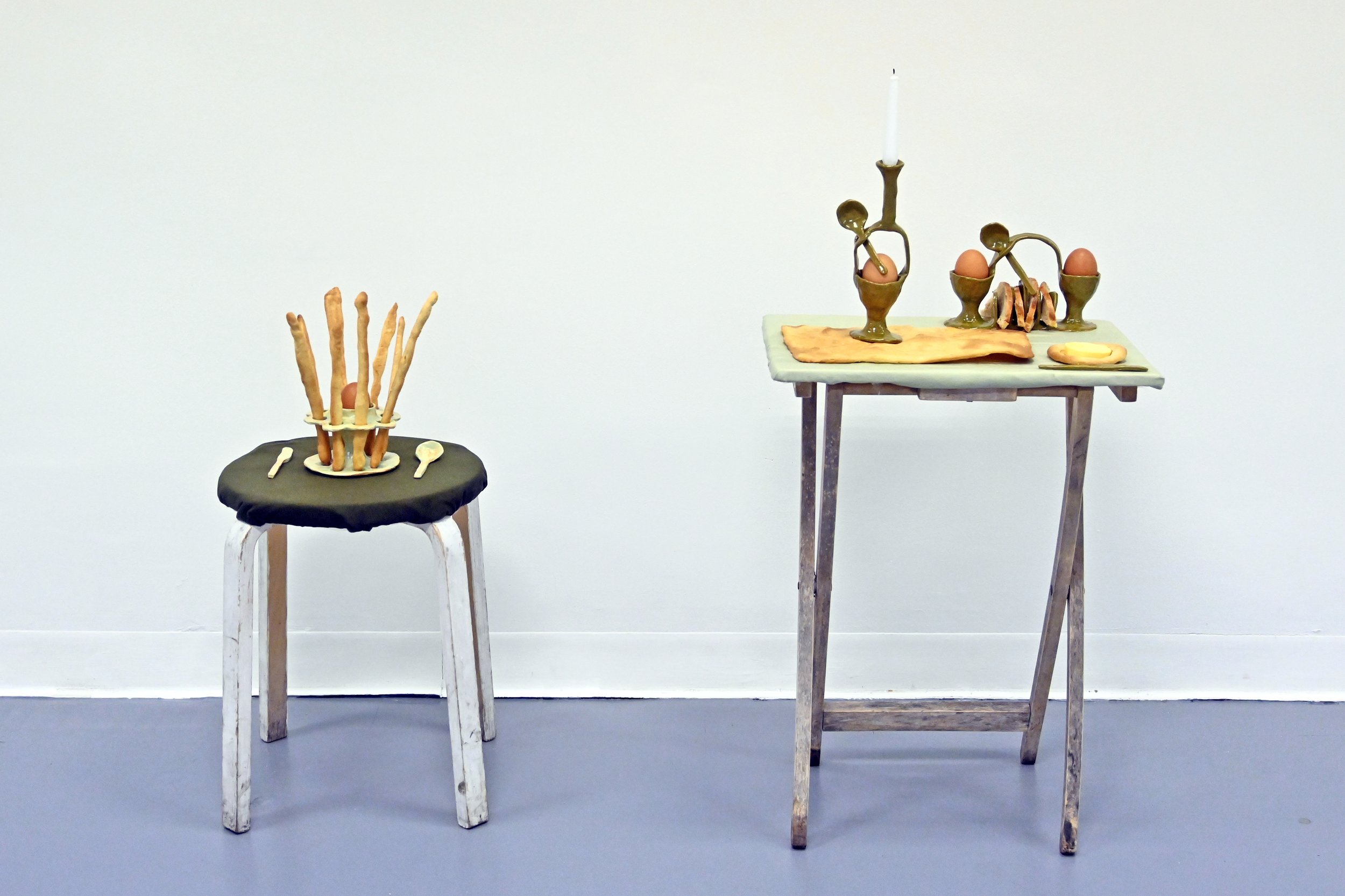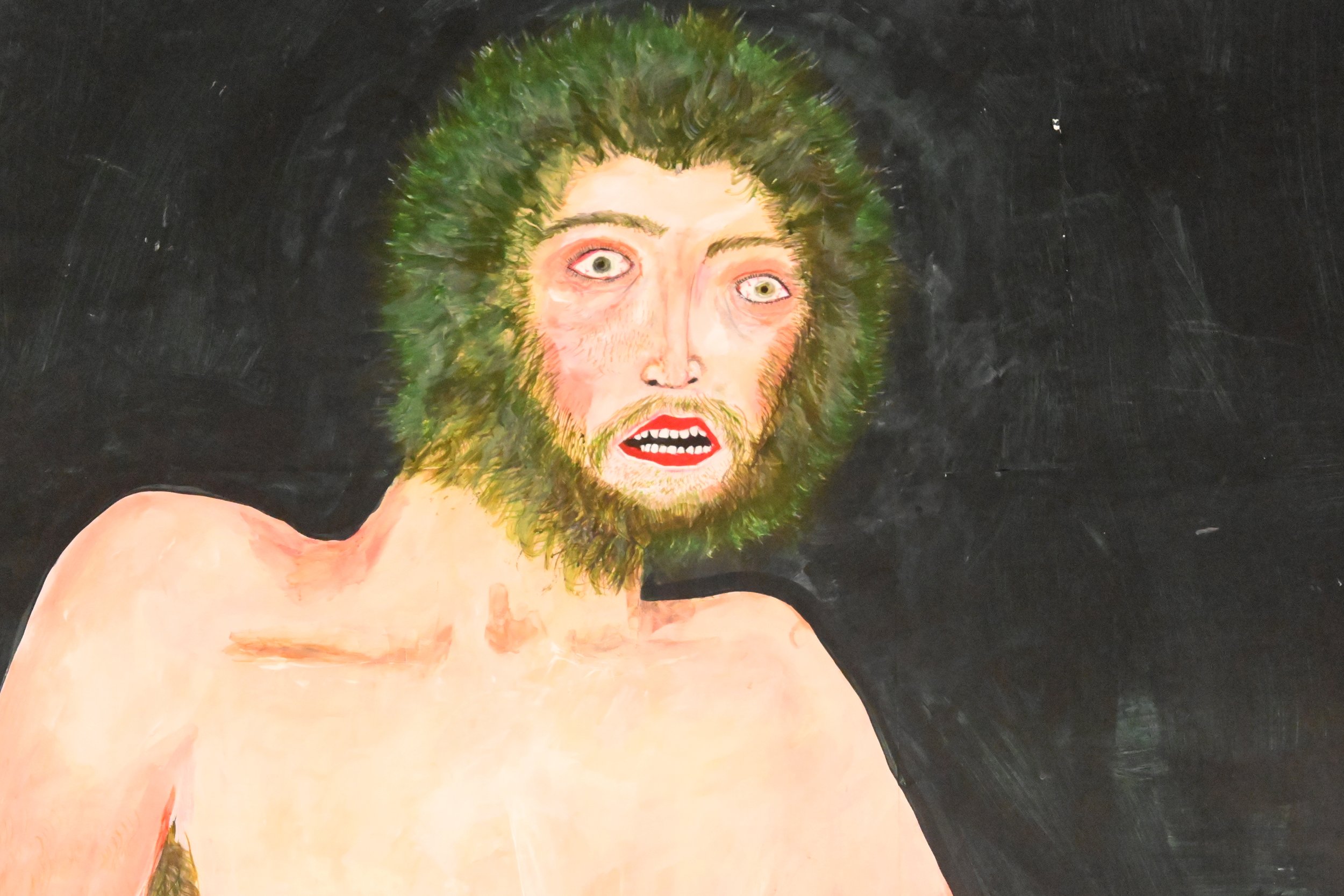Loose Time
4-7 August 2021
‘Loose Time’, 2021, installation view
Sarah Bird, Hannah Christy, Susie Davies, Taya Franco, Ben Haley, Gabriella Jeans, Aidan Knowles-Levitt, Pheobe Law, Tom Lines, Kitty McKay, Micaela Perrot-Barnaby, Rhubarcode, Elizabeth Simpson and Eoin Mackay, Bethany Stead, Ellie Stone, Matilda Sutton, Thomas Tyler, Roman Vaughan-Williams, Maya Wallis, Emma Wiseman
What will we call the time from now? How will we refer to it, if indeed we will? Maybe as an absence, maybe as a monotonous void. Maybe as a time to reflect and radically change one’s outlook and priorities. Maybe all the above, or maybe none; but the past 16 months has certainly changed time(s) – reconfigured it. In ‘Loose Time’, a selection of Newcastle-based emerging artists grapple with what this time has meant for them in its hindrances and in its flourishing. For the majority of the artists in this exhibition, it’ll be the first time they have shown their work in a physical space since graduating, and many had their studies interrupted. What binds these disparate artists is a common isolation and with that comes a thematic commonality. Darkness, isolation, hope, politics, and the importance of connectivity are at the centre of this playful and experimental exhibition.
Taya Franco, Garden Party, 2021, ceramic and fabric installation, dimensions variable
Emma Wiseman, Dreams of the organs, 2012, mixed media installation, dimensions variable
Sarah Bird is an artist and recent graduate of Architecture and Urban Planning at Newcastle University, creating playful interventions within the urban landscape to disrupt and engage in new dialogues and ways of seeing.
Hannah Christy works with food, text, clothing, photography, and sculpture. Her work responds to the interconnected relationship between things and sensations.
Susie Davies works predominantly with documentary film, but more recently also with music and sound. Her work revolves around local culture and recent history and explores topics such as regeneration of space, the artist’s role in society, and collective action.
Ben Haley, Tea For One, 2021, clay, mixed media, 65x47x39cm
Thomas Tyler, My Life As My Own Death, 2021, mixed media on wood, 21x30cm
Taya Franco is interested in re-imagining the past to reconfigure reality – in the world of possibility that daily, alienating life does not lend itself to. She is interested in the intersection of politics, materiality and the ethereal. Her objects nestle in the space between words and worlds, and reference a future always encroaching but never to be.
Ben Haley uses polymer clay, found objects, and virtual reality to create unique narratives. These narratives form the background of worlds that exist between the physical and the digital and use naïve technique to blend the two together. Haley’s work encourages a physical viewer to imagine experiencing the work digitally and vice versa.
Gabriella Jeans weaves art and magick to describe, celebrate and sometimes alter the fabric of reality. Her multimedia practice combines witchcraft, chaos magick and technomancy to produce ‘active spells’ which challenge contemporary occultism as well as the role of contemporary art.
Aidan Knowles-Levitt uses experimental sound, video and performance to explore quietness, repetition, hauntology and liminality. These reoccurring themes are informed by an interest in late capitalism and its cultural and political effects.
Pheobe Law uses sculpture, sound and installation to explore the human tendency to divide, organise and regulate. Recently, she has been re-appropriating and morphing functional objects into odd farm-like environments, giving an alternate perspective on the culture we have towards livestock, dairy and urban wildlife.
Tom Lines has recently been using sound, digital imagery and interactive installation to explore our relationship with non-human organisms. Themes include: the destruction of global ecologies, the animals we share our own environment with, and the artificial intelligences that influence our behaviour.
Matilda Sutton, Piss Pot, 2020, acrylic on constructed paper, 215x129cm
Elizabeth Simpson and Eoin Mackay, Untitled, 2021, acrylic on MDF, 91x61cm
Kitty McKay is an artist and one half of the collaborative walking project, INCURSIONS, with Archie Smith, which explores cityscapes and civic community through practices of socio-psychogeography, collective storytelling and participatory research. Both McKay and Smith share an interest in what is lost or missing in the neoliberal city, and what can be conjured in resistance.
Micaela Perrot-Barnaby’s work encompasses painting, text and sculpture to create immersive installations. Using the ironic value of ‘camp’ aesthetics along with circus and fairground devices, she explores the sinister side of heightened desire and emotions – providing a setting for escapism, glamour and also uncertainty. Perrot-Barnaby currently centres her practice around her love for monster trucks to introduce voluntary and romanticized chaos and a yearning for more.
Rhubarcode looks at the overlooked; she especially appreciates the surreality and naïve clunkiness brought about by the technical limitations of early CGI. She exploits intricate, technical methods of artmaking for intuitive and playful means. Characters and shapes are dissociated from their original purpose, by which the systems in which they typically function is exposed.
Elizabeth Simpson and Eoin Mackay use brushwork and shadow play to create non-photorealistic images. Reconnecting with their practise over lockdown, they have used vibrant colours and natural textures to explore the concept of ‘Loose Time’.
Bethany Stead uses laborious materials and techniques associated with traditional craft and folk art, often assigned to humans of a particular class, sex and gender. Working between clay, wood, textile and paper, Stead manipulates these mediums to provoke conversations about the societal barriers they, and others face. Subtly sensual and often playfully mischievous, their surreal hand-sculpted vessels and drawings dissect the uncomfortability and awkwardness of inhabiting a body, hinting towards aspects of folk dress and haute couture.
Ellie Stone explores the crossover, isolation and alteration of our senses through the occasion of dining. By creating interactive dinner sets, consisting of fun dining ‘tools’ with elements of humour running through their impracticality, she aspires to bring people together to share and communicate through the joy of dining.
Matilda Sutton works between painting, sculpture and textiles, dealing with two interwoven and often synonymous subjects: the woman and the animal. Usually made on constructed or collaged surfaces, the paintings and hangings depict figures somewhere between ‘humanness’ and ‘animalness’. Sometimes these images occur as scenes; hairy characters caught in various actions and glances; or sometimes they appear as arrangements or hybrids of symbols and objects.
Gabriella Jeans, Stranded, 2021, mixed media, 20x20x25cm
Elizabeth Simpson and Eoin Mackay, Untitled, 2021, acrylic on paper and wood, 28x22cm
Thomas Tyler’s work is a response to a condition he believes is descending into further simulation, and a search for ‘truth’ in the age of post-data. His practice is a multidisciplinary study of noise, noise being a grey area far from reason, but not quite absurd. Recent work has manifested into collage, both visual and sonic. My Life As My Own Death is a mixed media collage fabricated from found objects, cut up drawings and paint – fragments of time layered until meaning is lost, and perhaps something else is uncovered?
Roman Vaughan-Williams explores notions of death and cessation within his practice. These notions are examined through a variety of lenses: economic, political, personal, and aesthetic. Utilising drawing print, installation and performance, Roman constructs an idiosyncratic visual style externalising an internal world through haptic arrangements pulled together from varied histories.
Maya Wallis is interested in the exploration of private moments of excitement, imagining and pleasure. By drawing on specific memories, Wallis takes a subjective approach in in analysing the interior adrenaline rush found in small acts such as listening to music, dressing and dancing. Through performance, text, print and sound, Wallis constantly questions how to allow an audience to witness these understated but explosive moments contained within her body.
Emma Wiseman creates fantastical psychedelic landscapes, situated somewhere within the entanglement of reality and dreams. The environments exist as interactive and immersive mind massages, that hypnotise the audience through sensory seduction, creating a space to pause, contemplate, and process, to help the viewers navigate and appreciate the wonderfully strange existence we find ourselves in.
Take a video tour of the exhibition
Share this page

















